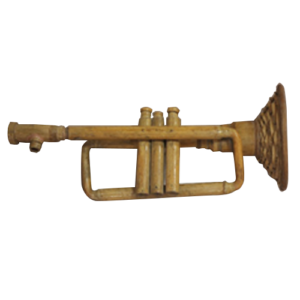Elementary Module
HIMIG KAWAYAN OF QUEZON CITY, LAGUNA, STA. MESA
- Volume 1
Background
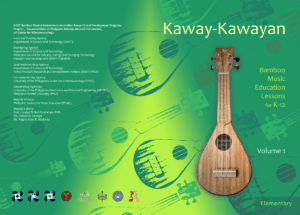
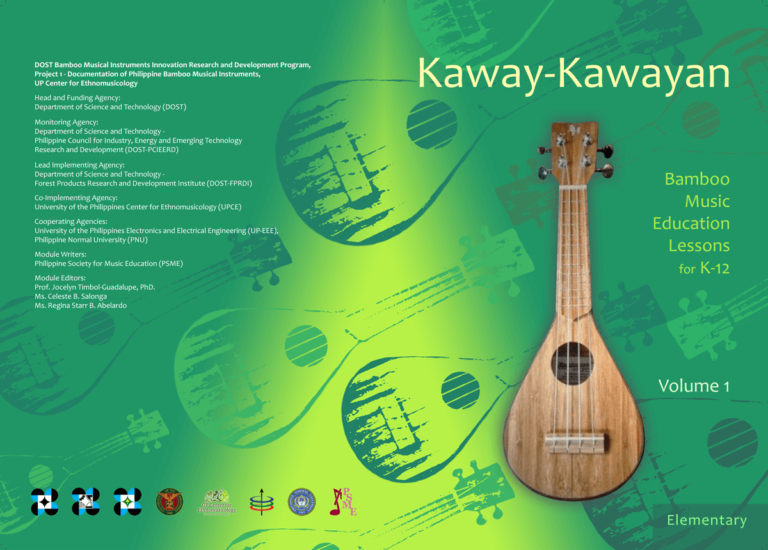
Excerpt from the BMI Ethnography of Quezon City’s Pangkat Kawayan
Musiko Bumbong of Pangkat Kawayan: The Glory of the Singing Bamboos of the Philippines By Janine Josephine Arianne A. Liao
A LIFETIME GUARANTEE: ELEVATING THE HUMBLE BAMBOO TUBE
Under the creative leadership of Victor Toledo, the old Pangkat Kawayan of Quezon City produced music using the bamboo instruments that were created, designed, and refined by the master himself. The current Pangkat Kawayan uses the same instruments that were made at least thirty years ago but have aged beautifully with the group. With the dedication and attention to detail evident in their quality, these instruments attest to the standard of a lifetime’s guarantee that can only come from meticulous research and production
One important aspect that I have noticed is that a major driving force for the creation of these instruments was for the bamboo instrument to be able to play a western, diatonic scale. In an article, Vic Toledo writes that the bumbong, or tuned bamboo tube, needs to play a complete scale, in tune, in order to make a beautiful sound. According to him, most bamboo instruments in the Philippines are “not tuned,” that is to say, pitches are indefinite in comparison to western tuning. This undertaking to tune the bamboo seems to stem from a very cosmopolitan outlook, indicating a desire to participate in a global music culture. It also indicates a strong local thrust in developing distinctively Filipino instruments through utilizing and perfecting bamboo instrument making and design.
Among the instruments that the Toledo makers crafted, the most unique and significant is the bumbong. These are thick in diameter and appear to be quite heavy. With a hole at the side, it appears as a thick transverse flute. However, unlike the thin flutes with multiple holes, the bumbong produces a single pitch per tube. They have a complete set of two and a half octaves. As Vic writes, it is a unique contribution of the Philippines to the world.
Another instrument that looks unique is the tipanklung or bamboo piano. It is similar to the angklung, or bamboo rattles from Indonesia. However, instead of these played separately by different individuals, the rattles are hanged on a frame and arranged like a piano, including the raised black keys. It looks like a curiosity, but once it is hanged like so, it is possible to be played by one person. When they performed for us, this instrument carried the main melody. This instrument is one of the later creations of Vic Toledo.
They also have an instrument that they call the Philippine angklung, the alugtog, which is played similarly by groups in an interlocking style. However, the appearance of the instrument features a different design, the most notable of which is the three- line staff with a black sixteenth note in the center. This appearance follows the western model and is a mark that signals its easy adaptability to western-style music.
Another form of bamboo rattles are the chord rattles. What is unique about this instrument is that each rattle is already made up of three pitches, forming a chord, which can be played by one person as accompaniment. The members who demonstrated these performed with choreography, with simple turns and forward-backward sways. They also have a marimba, whose bars are made of narra and resonators made of bamboo instead of metal. The marimbas in the group play melodies, harmonies, and obbligato fills in the music arrangements. I noticed that the senior members of the Pangkat Kawayan were the ones who played the marimba.
An interesting instrument was lying at the corner of the Pangkat center. According to Beth, it was not used anymore. It was the tunog hagdan bamboo instrument. And true enough to its name, it looks like a ladder. The “steps” are made of narra bars, and can be classified as a xylophone instrument. Beth demonstrated the instrument for us by performing the song Pipit which was arranged by Vic Toledo. This instrument is unique to Pangkat Kawayan and is said to be one of Vic’s many musical instrument inventions.
Lying at the sides of the Pangkat center were the gabbang. The gabbang is a xylophone found among indigenous people in southern Philippines. However, according to Chino, these were not tuned and were therefore not used at all.
Finally, a curiosity of a piece was the sungkit. There was only one available, and as they said, it was for aesthetic purposes, and did not function for sound at all. It was a long piece of bamboo, similar to a sungkit or a device used to get fruit from trees.
The Toledo bumbong instruments have been around for a long time and are cleaned with alcohol as they have been shared all these generations. But these are indeed of good quality – well-aged, solid-sounding, and sturdy. For minor repairs, they just apply white glue, and for finetuning, a small piece of wood is attached to the inside, and I believe this small piece can then be maniulated to alter the tuning of the bumbong.
Currently, the sets that they use are stored in the Pangkat Kawayan center, but they can be easily packed for travel. Even the tipanklung can be dissembled for easy shipping. Aside from the ones used in performance, there are still some instruments around. These spares are stored in the Pangkat Kawayan center, but some are still at the Toledos’ house. There also may still be broken sets of angklung, still untuned. Sadly, those without storage space have been thrown away.
Meanwhile, a different form of invaluable wealth can be found in the Pangkat Kawayan Center: posted on the walls are articles on bamboo written by Victor Toledo himself. One of these articles is a collection of excerpts from a Japanese book on bamboo that he translated. Another is a treatise on the history of the bumbong (bamboo tube) as a cultural item and a musical instrument in the Philippines that he co-researched with a Vicente Toledo, professor of Spanish language and music in University of Manuel L. Quezon. Most noteworthy is this article that provides direct insight into the manufacturing process that Vic Toledo had mastered. An outcome of his personal experiences, research, observations, and consultations with builders and carpenters, this article discusses in detail the process of choosing and treating of bamboo, as well as cutting it and putting the pieces together to form instruments.
First, Vic shares that it is best to cut bamboo during summer. In the rainy season, the bamboos have new shoots, and these young sprouts have a “sweet” essence that attracts bukbok (rice weevils) which damage the bamboo. If cutting bamboo during the rainy season is unavoidable, it is best to soak it in vinegar in order to counter its “sweetness” and prevent it from being attacked by bukbok. Once the bamboo is dried, wood treatments like Solignum can be used. Wood varnish – regular wood varnish, according to Vic’s son Chino – was also applied to the bumbong found in the Pangkat Kawayan Center, but Vic does not mention this in his articles. Also discussed is the use of sandpaper as a seal of sorts and how it provides better resonance, possibly due to the rough surface. This may be a unique practice to the Toledo makers.
Next, Vic warns against using old or mature bamboo. Older bamboo tubes, which can be identified by their telltale reddish tone, easily break and do not have the ideal sound. He says that the ideal age for bamboo for instrument making would be around five years, when bamboo possesses sturdy and strong fibers and a clear, bright sound. Clearly, he also cautions against using cracked, bent, or crooked bamboo tubes, as these cannot be tuned properly. He further shares that tropical bamboos have harder fibers, thus producing a bright and clear sound as opposed to bamboos that grow in more temperate regions, which in turn have softer fibers, therefore producing a softer and unclear tone.
Vic shares an interesting observation about how to tell if the bamboo is cut in the morning or at noon just by examining the “buko” or “eye” of the bamboo. He says that the buko is “closed” in the morning, but gradually opens up at noon time. He continues that that it is a trait of tropical bamboos but does not go any further to tell what this information may be used for. However, he enumerates four factors that affect the tuning of the bumbong: 1) the thickness or thinness of the bamboo; 2) the hardness and age of the bamboo; 3) the length, diameter, and the actual hole of the bamboo; and 4) the location or position of the hole for blowing into the tube. He emphasizes the importance of where the blow hole is bored into the bamboo tube as it affects the exactness of the pitch.
Chino recalls amusing stories of how his father, almost mesmerized by the beauty of the bamboos, would point at bamboos along the highway and remark if these were suitable for instrument making or not. This is truly a mark of the master craftsman who knows his materials well. In his articles, Vic mentions bamboo kalabaw (more commonly known and also referred to as kawayang tinik in the Pangkat Kawayan Facebook page). He refers to it with the scientific name of bambusa blumeana and says that is the best bamboo for making instruments. Vic recommends this species because it possesses the right thickness, ideal fiber density, and a bright sound, making it easy to tune properly. Initially, the Toledos sourced their bambusa blumeana from their hometown in Nueva Ecija, where right behind their old house bamboos grew abundantly, but for a time, they were also sourcing bamboos from Montalban.
Bamboo, however, is not the sole material for the Toledo instruments. Narra wood, for example, was used for their xylophone slabs, particularly the marimbas. Chino explains that slabs made from narra wood give a good sound and at the same time, are sturdy and do not break so easily. According to him, they also tried yakal, but it had no sound at all. Yet bamboo is still a necessary material for the marimbas, as it is used as resonators to amplify the sound of the slabs. A quick glance shows these bamboos to be of uneven length. The main reason for this is that the nodes, and not the length or entirety of the bamboo, are the ones tuned to the slabs. This is why, according to Chino, bamboo tubes are cut from node to node. In fact, when bamboo tubes don’t have a node – as seen in some of the bamboo resonators – their bottoms are sealed off with an artificial cover to simulate a node so that they can be tuned to the necessary pitch. For some of the lower pitches, tuning the tube is not as important, but the tube is still necessary for increasing volume. As for the other resonators, some are there just for aesthetic purposes, in order to fill in the gaps in between the actual bamboo resonators.
When asked about what the main innovation contributed by his father and grandfather could be, Chino said that it is not in the instrument design, but rather in the process of making the instrument. Truly, the meticulous process is astounding in itself and is the main reason for their quality and durability. As his son Chino would say, Vic Toledo’s efforts in perfecting bamboo instrument making and design stem from his passion in treating the bamboo not as a toy or souvenir but an instrument built to last a lifetime.
A. Content Standards
Demonstrate understanding of variations of sound density in music (lightness and heaviness) as applied to vocal and instrumental music
B. Performance Standards
Participate in a group performance to demonstrate different vocal and instrumental sounds
C. Learning Competencies/Objectives
- Identify aurally and visually different instruments in Himig Kawayan/Pangkat Kawayan
- Participate actively in instrumental ensemble
Instrumental music of Pangkat Himig Kawayan
- Angklung
- Marimba
- Bumbong
A. Materials
- Print Materials
BMI ethnography on angklung, marimba and bumbong:
a. BMI ethnography of Quezon City’s Pangkat Kawayan
b. BMI ethnography of Laguna’s Kawayan Music Ensemble
c. BMI ethnography of Mesa’s Banda Kawayan
- Audio-Video Materials
a. Angklung Videos
-
-
- Angklung – Himig Kawayan tutorial
- Indonesian Angklung
- Angklung Performance
-
b. Marimba Videos
-
-
- Marimba – Himig Kawayan tutorial
- Philippine Music: Dipolog Marimba Nais Ko
- Banda Kawayan Plays Pinoy Music
-
c. Bumbong Videos
Himig Kawayan tutorial
d. Pangkat Kawayan Videos
e. Musikawayan /D’ Original Musikong Bumbong 1896 Videos
f. PUP Banda Kawayan/Banda Kawayan Pilipinas Videos
g. Bocaue Central School Musikawayan Videos
h. Musikawayan ng DepEd, Bocaue Videos
- Music Score
a. “Manang Biday,” arranged by Genaro Cesar Edilo

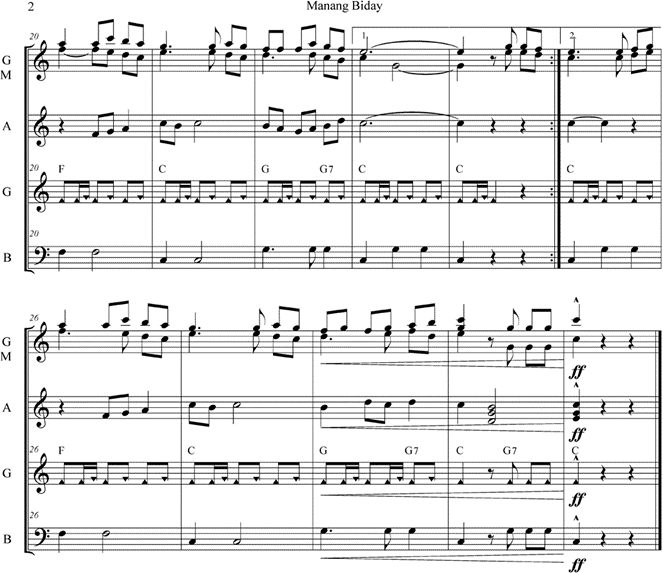
b. “Pambansang Awit,” arranged by Genaro Cesar Edilo
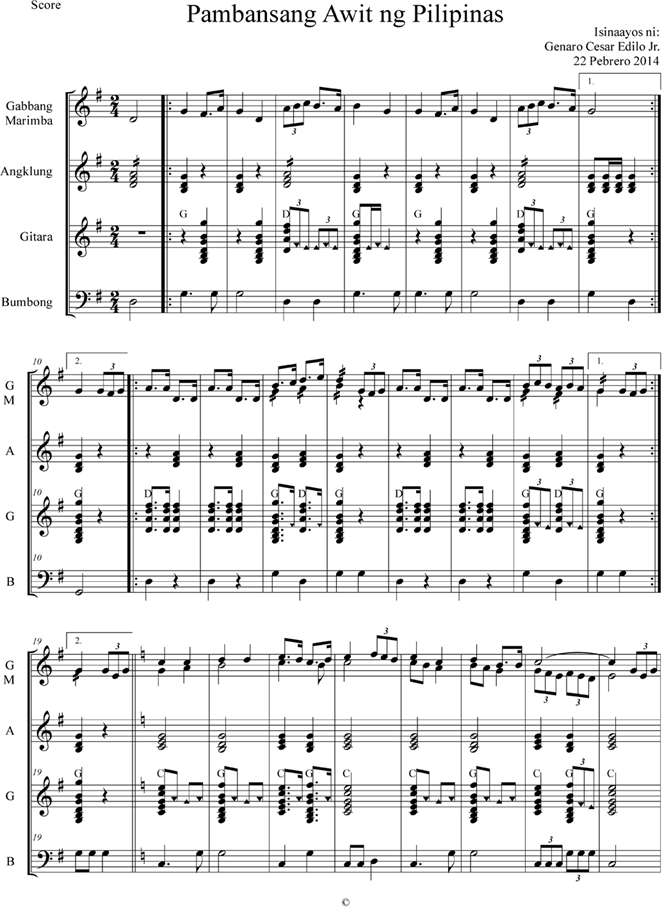
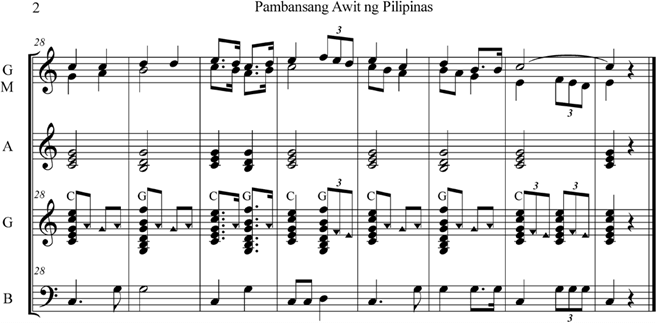
B. Other Learning Materials
- Piano Chords Tutorial Videos
- Basic Articulation Videos
A. Reviewing the previous lesson or presenting the new lesson
- Discuss legato and staccato articulation through singing and listening to musical
- Review lessons on chord
B. Establishing the purpose of the lesson
Tell the students that through the discussion on the Himig Kawayan ensemble, they will be able to:
- Identify visually and aurally the basic instruments of the ensemble
- Explain the functions of the instruments and describe basically how the instruments are played
- Play with some of the instruments of the ensemble
- Identify some of the founders/ manufacturers of the instruments and develop appreciation for the Himig Kawayan ensemble.
C. Presenting examples/instances of the new lesson
- Tell the students that they will be watching a video of a Himig Kawayan Ask them to identify and write down the instruments that they will recognize in the video presentation.
- Let the students watch a video on the performance of any of the following Himig Kawayan groups:
a. Pangkat Kawayan founded by Victor Toledo
b. Musikawayan founded by Gilbert Ramos
c. Banda Kawayan Pilipinas founded by Siegfredo Calabig
D. Discussing new concepts and practicing new skills # 1
- Ask the students to study the list of instruments that they made and to classify them according to the general classification indicated on the board. Let the students explain the basis of the classification on the board. The students should be able to identify and classify the following:
a. Angklung – idiophone
b. Marimba – idiophone
c. Bumbong – aerophone
- Ask students to explain how the instruments are played as well as the functions of the individual instruments in the context of the ensemble as presented in the videos. Discuss that there may be other bamboo instruments tuned diatonically or other percussive bamboo instruments included in the Himig Kawayan ensemble as seen in the
- Let the students watch tutorial videos on angklung, marimba and bumbong for more information.
E. Discussing new concepts and practicing new skills # 2
Option 1 – If there are available Himig Kawayan instruments
- Identify the founders/manufacturers of the Himig Kawayan instruments and discuss their contribution to Philippine musical tradition.
- Distribute the pieces of angklung to the Demonstrate the manner of playing the instruments and other playing techniques. Let the students play the C major scale in legato manner then in staccato manner.
- Guide the students in learning and performing “Manang Biday” through any of the following techniques:
a. Reading the notes of the piece (if students are note readers)
b. Memory (through an assignment, ask the students to memorize the piece before this lesson on Himig Kawayan)
c. Teacher points at the players one note at a time
- If the students can perform the angklung part on their own, play or ask anyone in the class to play the marimba part (and bumbong) as indicated in the (The bumbong among the Himig Kawayan instruments is the most difficult to play. However, it can easily be learned through correct formation of the lips. Refer to the video on bumbong tutorial.)
Option 2 – If there are no available Himig Kawayan instruments
- Identify the founders/manufacturers of the Himig Kawayan instruments and discuss their contribution to Philippine musical tradition.
- Let the students watch more videos on:
a. Individual Himig Kawayan instruments
b. Himig Kawayan ensemble presentations
F. Developing mastery (leads to a formative assessment)
Option 1 – If there are available Himig Kawayan instruments
Have the students perform the first part or the whole piece of “Manang Biday” (depending on their skill or capacity). Let them practice playing the music, observing good phrasing and articulation with the end goal of achieving beautiful music (within the bounds of the time allotment for the class).
Option 2 – If there are no available Himig Kawayan instruments
Ask the students to identify the other instruments in the Himig Kawayan ensembles aside from the basic instruments discussed earlier. Let the students describe how the manner of playing and the material used in the instrument affect the quality of sound of the instruments.
G. Finding practical applications of concept and skills in daily living
Ask the students how playing together in an ensemble of angklung/ Himig Kawayan can be likened to the members of a family or to the different parts of our body in terms of function, contribution, or role.
H. Making generalization and abstraction about the lesson
Ask the students to: identify the basic instruments of the ensemble; describe the functions and the manner the instruments are played; identify the founders/ manufacturers of the Himig Kawayan ensembles and their contribution to the Philippine musical tradition.
I. Additional activities for application remediation
Option 1 – If there are available Himig Kawayan instruments
- Assign students to their respective Himig Kawayan instruments and ask them either to finish working on “Manang Biday,” part A and B (if the whole piece was not played during the class because of time constraints); or practice refining the whole piece with the correct
- Have the students perform the piece in the following meeting for a practical test (using rubrics on instrumental performance).
- As a supplemental activity: Teach the students how to perform “Pambansang Awit” in another
Option 2 – If there are no available Himig Kawayan instruments
Assign the students to research on the history of any of the groups of Himig Kawayan listed below. For the next meeting, ask students to present their findings to the class.
- Pangkat Kawayan founded by Victor Toledo
- Musikawayan founded by Gilbert Ramos
- Banda Kawayan Pilipinas founded by Siegfredo Calabig
A. How many learners earned 80% in the evaluation? How many learners require additional activities for remediation?
B. Did the remedial lesson work? How many learners have caught up with the lesson? How many learners continue to require remediation?
C. Which of my teaching strategies worked well? Why did this work?
D. What difficulties can my principal or supervisor help me solve?
E. What innovation or localized materials did I use/discover which I wish to share with other teachers?
Science in a creative industry.
The DOST-FPRDI has a Bamboo Musical Instruments Innovation R&D program aimed at improving the quality of locally-made bamboo musical instruments (BMIs) through science and innovative technologies. The program seeks to standardize the production of selected BMIs, develop prototype designs, analyze raw material sources and existing markets, and build a BMI processing facility. In addition, the program aims to document the ethnocultural story behind several BMIs and identify the bamboo species used in BMI production to promote public awareness and appreciation of the cultural importance of these musical instruments. The program is a collaboration with the University of the Philippines and Philippine Normal University for teaching modules and analyzing sound quality and standardization of BMI design. The DOST Grants-in-Aid program provides funding.
PhBMI

